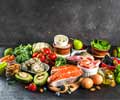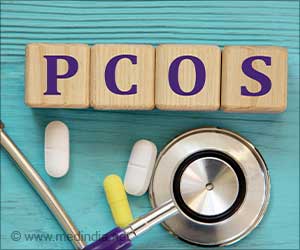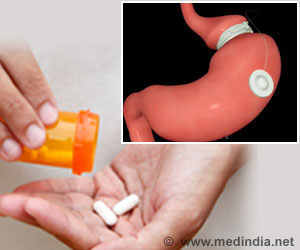Drug used to treat bacterial infections could increase the metabolism and attenuate the weight gain induced by a fatty diet in tests with mice.

‘Enoxacin, a broad-spectrum antibiotic that has not been used in clinical practice, could improve metabolism and reduce the chance of weight gain.’
Read More..




"The purpose of the study was to prove a principle, to show that it's possible to increase energy expenditure and reduce the harmful consequences of obesity by acting pharmacologically on a metabolic pathway of interest," Mori told Agência FAPESP.Read More..
"We are not proposing use of this specific drug to combat weight gain. Our results point to ways of finding compounds that act on the same pathway more effectively and safely."
The substance used in the experiments was enoxacin, a broad-spectrum antibiotic that has not been used in clinical practice since the emergence of more effective drugs in the same class (fluoroquinolones) some years ago.
According to Mori, it was chosen on the basis of studies showing that it can modulate the production of microRNAs in adipose tissue. MicroRNAs (or miRNAs) are short non-coding RNAs that regulate gene expression.
"Previous studies in animal models and humans indicated that interventions capable of extending longevity and improving metabolic health, such as physical exercise and caloric restriction, promote this benefit by increasing adipose tissue's capacity to process mirRNAs. In other words, these practices modulate the pathway responsible for miRNA biogenesis," Mori said.
Advertisement
Laboratory experiments
Advertisement
In one of the protocols the researchers added enoxacin to the differentiation cocktail, and at the end of the process compared the mature adipocytes with a control culture not exposed to enoxacin. The analysis showed that in white adipocytes the drug triggered expression of PPARGC1A and UCP1, genes that are significantly active in brown adipose tissue cells under normal circumstances.
The proteins encoded by these two genes are considered molecular markers of thermogenesis. The conclusion was that enoxacin induced browning by reprogramming the white adipose cells to dissipate energy in the form of heat instead of storing it as fat.
"The protein UCP1 acts on mitochondria [energy-producing organelles] by uncoupling the electron transport chain used in the synthesis of ATP [adenosine triphosphate, a molecule that serves as fuel for cells. This makes the cells dissipate energy as heat," Mori said.
"To understand the process better, we can compare it to the damming of a river to produce electricity. If holes are made in the dam, the difference in elevation that should be used to drive the turbine is dissipated without generating the desired energy."
In the second protocol tested in vitro, the differentiated adipocytes were exposed to enoxacin for 24 hours and then analyzed. The researchers found that the cells expressed the same markers of thermogenesis, showing that the white adipocytes now formed had also undergone browning.
Functional tests showed that both antibiotic treatment protocols led the white adipocytes to "breathe" more deeply, i.e. consume more oxygen than the untreated cells even under the same conditions.
Activated by cold
According to Mori, the experiments with mice replicated the thermogenic effect observed in vitro. In this case, the enoxacin was administered by intraperitoneal injection. Oral administration of an antibiotic could be harmful to gut microbiota and interfere with the results.
Several different protocols were tested. In one protocol, the researchers fed a group of rodents a high-fat diet for a month before starting the treatment with enoxacin.
The mice were given the drug once a day from Monday to Friday for ten weeks, and the fatty diet was maintained throughout the period. At the end, the control animals (given placebo) displayed a weight gain of 13 grams (g) on average, while those treated with the antibiotic had put on 8 g.
"The weight gain curve began diverging between the two groups as soon as administration of the drug began," Mori said. "The control group's weight gain continued to rise strongly, while the treated group's curve became less steep. At the end we found the treatment also led to enhanced insulin sensitivity and glucose tolerance."
Analysis of adipose tissue evidenced increased expression of thermogenesis marker genes PPARGC1A and UCP1 in both white and brown adipose cells.
However, the beneficial effect on the metabolism was observed only when the mice were exposed to mild cold stress (about 24° C) or severe cold stress (in the range of 6o C). When thermoneutrality was maintained (about 30o C, the ideal temperature for these mice), enoxacin was not found capable of activating thermogenesis, indicating that the drug intensified the action of cold.
To find out whether the effect observed in the mice exposed to mild cold stress depended on the drug's action on gut bacteria, which are known to influence weight gain, the researchers repeated the experiment using germ-free mice bred under controlled laboratory conditions to be totally free of microbiota. Enoxacin also promoted thermogenesis in this experiment.
"The fact that the drug doesn't work in thermoneutrality reduces its potential for use as a sole treatment for obesity, but it can help us understand the mechanisms involved in the process or be used as an adjuvant," Mori said. "In any event, we expect to find a molecule with even more powerful thermogenic action and without the side-effects of an antibiotic."
Substances marketed for this purpose already exist, but according to Mori some excessively stimulate the adrenergic system, which regulates the fight-or-flight response to threats, and can cause cardiac arrhythmia and even a heart attack. Others are even more dangerous, chemically uncoupling the inner mitochondrial membrane and increasing cellular energy expenditure.
"The problem with current interventions is that they have systemic effects, acting on various cell types including even neurons and cardiomyocytes [heart muscle cells]," Mori said. "They can cause cell death and affect important processes in the organism."
Action mechanism
In the last stage of the investigation, the researchers sequenced all the mirRNAs expressed in the adipose tissue of the treated mice as well as the control mice. The initial analysis showed that the treatment altered the expression of a few dozen mirRNAs.
"We cross-tabulated our results with data from public repositories in search of miRNAs regulated by both enoxacin and other interventions that induce browning. We eventually arrived at miR-34a-5p, which is consistently modulated both by the drug and by caloric restriction and cold stress," Mori said.
Enoxacin may interfere in the processing and stability of miR-34a-5p, he added. Because it suppresses signaling by hormones, including FGF21, which promotes energy expenditure, a reduction in miR-34a-5p intensifies the thermogenic stimulus.
Researchers at AstraZeneca collaborated with Mori's group in this investigation. On the basis of the findings, UNICAMP and the pharmaceutical company are testing molecules with similar structures to enoxacin but without antibacterial effects.
In vitro experiments have had promising results, pointing to compounds with even stronger thermogenic action than the original molecule and without microbicidal effects.
Source-Eurekalert












